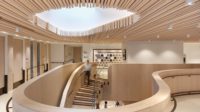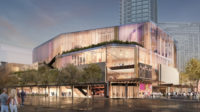Stepping through the front entrance of Casey House, the first thing you see is a hearth. The main doors of the Toronto hospital for HIV/AIDS patients open to a tall lobby, lined with rough-cut and honed limestone and centered on a fireplace. The symbolism is clear: this is, as the name suggests, a place to feel at home.
Additional Content:
Jump to credits & specifications
That’s a rare quality in a health-care facility, but it is crucial to the care and culture here at Canada’s only independent HIV/AIDS hospital. Founded as a hospice in 1988 by journalist and activist June Callwood and named for her late son, the institution is located in Toronto’s Gay Village. Its clients, as the hospital prefers to call them, include a sizable number of homeless people. “Our clients tend to be very much in the margin,” says Casey House CEO Joanne Simons. “Most have suffered some form of trauma in their lives. We hope within this space to empower them so that they can take care of themselves and feel compassion, dignity, and worth.”
The design by Toronto-based Hariri Pontarini Architects (HPA), which won a 2018 national Governor-General’s Medal in Architecture from the Royal Architectural Institute of Canada and the Canada Council for the Arts, does just that. Completed in 2017, the project connects 59,000 square feet of new construction with a grand 3-story Victorian house dating back to 1875. The U-shaped addition, which combines a 3-story linear masonry volume punctuated by a taller glazed tower, creates a perimeter block that runs predominantly east–west, surrounding a courtyard planted with shrubs and loquat trees. “From the garden outward, this place is life-affirming and life-giving,” says architect Siamak Hariri. “It tries to respond to the challenge, ‘How do we create a sense of warmth, intimacy, and care?’ ”
One answer, visible in the atrium, is through the use of natural materials. HPA added custom millwork in strategic places, such as the lounge and the nurses’ station on each floor, using walnut and Algonquin limestone finished with special coatings that allow for frequent sterilization. In health-care facilities, “normally you would get stainless steel and Corian,” Hariri says. “Here you get stone, wood, elements that create a sense that you’re not in the hospital.”
The abundance of natural light, enabled by the unusually small floor plate and perimeter-block layout, enhances that effect. The architects stacked 14 inpatient rooms on the upper floors, in single-loaded corridors that overlook the garden. In this area, the hospital delivers palliative care to patients at the end of their lives and, more frequently, specialized subacute care—often treating illnesses that occur alongside HIV/AIDS, helping patients through post surgical recovery and helping them organize future care. Each of these private rooms has outward-facing windows with highly reflective glazing. The courtyard ends to the east at the atrium, which in turn is lit through a skylight. “At certain times of day, you see a shaft of light cut through into the center of the building,” Hariri says. The rest of the main floor, meanwhile, houses a cafeteria and clinic facilities for an outpatient program that serves 200 patients per day.
Casey House, like all hospitals in Ontario, sees its operations and capital costs largely covered by the provincial government. The remodel and addition were funded in part by an $8 million private capital campaign. But Casey House’s design goes outside the government’s usual guidelines, in part through its adaptive reuse of a Victorian house. That building, its interior restored by ERA Architects, contains administrative offices as well as space for counseling sessions and public events. Subtle adjustments to the floor levels allow continuous barrier-free access—and visual connections—between new and old facilities. The house provides a very public front door, facing Jarvis Street—once Toronto’s best residential address and now a heavily trafficked artery. This, Simons explains, is critically important: while patients value their privacy, “we want to fight the blame and shame associated with HIV,” she says. Accordingly, Hariri’s team designed the long southern facade of the building, which faces a side street, to resemble a quilt—an art form that, in North America’s gay communities in the 1980s, became a device to memorialize those lost to HIV/AIDS. The elevation is woven of roman brick in three hues, dark tinted glass, and crust-faced limestone. It is a subtle but very public piece of symbolism that expresses the institution’s values in architectural form. “In the ’80s, during the HIV crisis, there was huge stigma around the virus,” says Simons. Now “we’re making a very bold statement,” she says. “We’re not hiding anymore.”
CreditsArchitect: Hariri Pontarini Architects
Personnel in architect's firm who should receive special credit: Partner-in-Charge: Siamak Hariri
Photographer: doublespace photography, 647.640.4868 |
Interior designer: Hariri Pontarini Architects & IBI Group
Engineers: Structural Consultant: Entuitive Consultants: Landscape Architect: Mark Hartley Landscape Architect General contractor: Bird Construction |













Post a comment to this article
Report Abusive Comment